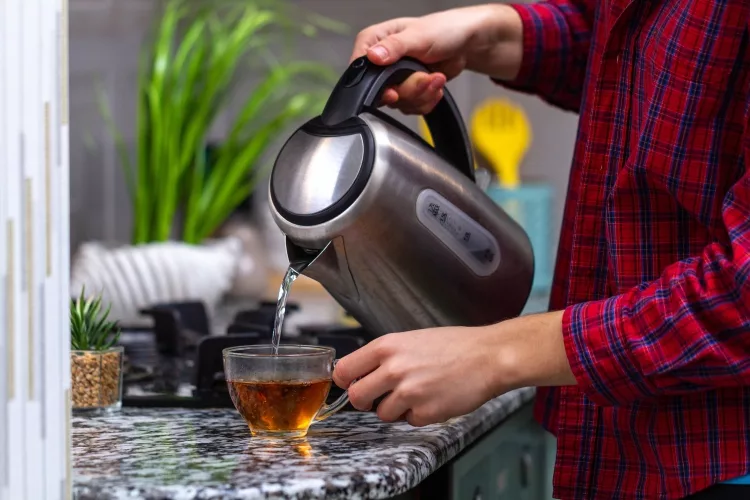How Does a Kettle Work
by Hari Won
Kettles are a household staple that have been used for centuries. The first kettles were made of cast iron and had to be heated over an open fire. Modern day electric kettles generally work on the principle of electromagnetic induction, although some models use a ceramic heating element or a stove-top design.
There are two types of modern day electric kettles, one is called a "coils" kettle where there is an electrically powered coil which has water passed through it by gravity from the top reservoir into the bottom boiling chamber. The other type is called an "evaporator" kettle where water is boiled in a sealed system with an electrical heat source at the bottom of the pot.
Contents
A kettle is a simple appliance that heats up water to boiling point. But how does it work? Kettles are made of metal, with the base being either metal or plastic. A heating element inside boils the water which is then collected in an enclosed chamber at the top of the device. The hot water can be poured out through a spout on one side and there's usually a switch for turning it on and off. The heat source may come from electricity, gas, or even tea light candles.
A kettle is a device that boils water by heating it to the boiling point. This can be done on an electric or gas stove, or with an open flame. The water inside the kettle becomes heated and evaporates into steam which forces its way up through the spout of the kettle because of atmospheric pressure, this causes bubbles to form in the liquid as it nears boiling point. Once boiled, you can use your Kettle for various purposes such as making tea, coffee etc.

How do kettles heat water?
Kettles are made up of many components that work together to heat water. The most important part of the kettle is the base, which heats water by sending it through a heating element. This process creates steam that rises into the spout and then flows out over your favorite tea leaves or coffee grounds.
- A kettle heats water by boiling it
- It does this by heating the liquid to its boiling point, which is 100°C (212°F) at sea level and decreases with altitude
- The pot holds the water in a closed environment, trapping steam within it
- This creates pressure that builds up inside of the pot until it forces hot liquid out through an opening into your cup or kettle below
- As long as there's enough water left in the kettle, you can keep refilling it for more hot beverages without having to wait for another boil cycle
- When you're done using the stovetop, turn off any elements so they don't continue to use electricity unnecessarily.
We don't know how it feels to be boiled alive, but we do know that the horror of the experience is enough to make anyone want to take a shower. Kettles heat water by using electrical current or gas flame. The current passes through metal coils and creates resistance which generates heat. This process is called Joule heating and can be found in many other appliances, such as microwaves and electric stoves.
Gas flames on the other hand, use natural gas or propane and burn at very high temperatures (around 3100°F). To boil water, kettles need a constant supply of fuel like natural gas or propane; if they were powered solely by electricity they would require about 2000 watts of energy input for one hour.
Is boiling water in an electric kettle safe to drink?

A recent study by the National Academy of Sciences has found that boiling water in an electric kettle is safe to drink. This comes after a string of incidents where people have become ill from drinking boiled tap water.
The study concluded that boiling water in an electric kettle will not leach lead or other toxins into the potable liquid, so this may be a safer option for heating up your morning cup of tea or coffee, but you should still use filtered water to make sure you're getting all the minerals and nutrients you need.
You might be surprised to find out that boiling water in an electric kettle is not safe. Why? The issue with electric kettles is that they have a heating element on the base of the pot, so when you boil water in one, it's actually being heated by electricity.
When the water reaches boiling point (212 degrees Fahrenheit), any impurities at the bottom of your kettle will vaporize and get into your drinking water. There are some ways to avoid this like using filtered or distilled water, but if you're looking for an easy way to make sure you're always drinking pure H2O then use a stovetop kettle.
What is the heating element in a kettle made from?
Kettles are a necessary appliance for any home. The heating element in the kettle is one of its most important parts, as it heats up water to your desired temperature. Kettles can be made from many different materials including copper, stainless steel and porcelain. If you want to find out more about what material your kettle is made from, keep reading.
Most people use a kettle to boil water. But how do you know what materials are in the heating element? The average electric kettle has an exterior made of stainless steel, brass or copper while the inside is either nickel-plated iron or some other metal alloys.

About Hari Won
Hari has been a close friend with Josh since kindergarten. Her place is right around the corner from Josh’s.
She claims they are only friends. Hari also loves to drink. By accident, she tried her first taste of beer in middle school; felt in love with them since then.
Life has been up and down lately for Hari. She and/or other friends often meet up with Josh for a few packs. They may drink through the night, while taking turn to tell their life stories.
Hari received her BS degree in biochemistry from University of Phoenix. She hoped to become a great brewmaster someday...
Thoughts on "How Does a Kettle Work"
 |
 |
 |
 |
Kitchen - Outdoor